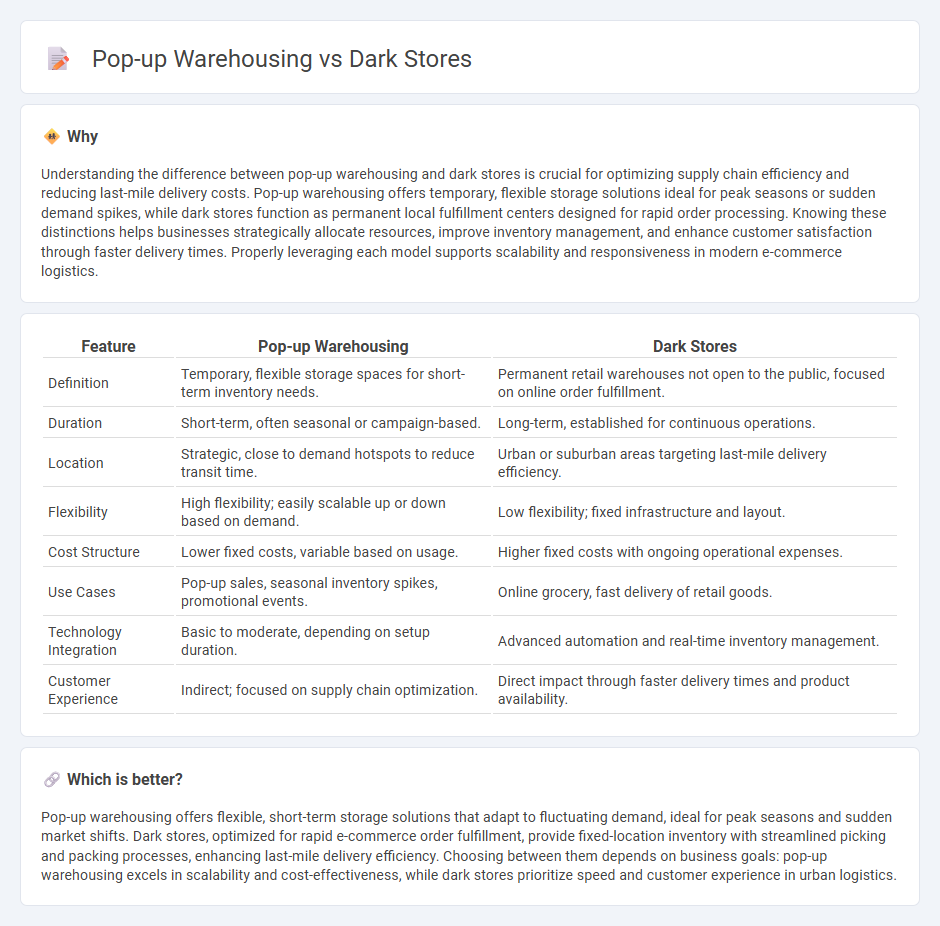
Pop-up warehousing offers flexible, temporary storage solutions that help businesses manage seasonal demand spikes without long-term commitments. Dark stores operate as dedicated fulfillment centers optimized for online order processing, enhancing last-mile delivery efficiency. Explore how these innovative logistics strategies can transform your supply chain management.
Why it is important
Understanding the difference between pop-up warehousing and dark stores is crucial for optimizing supply chain efficiency and reducing last-mile delivery costs. Pop-up warehousing offers temporary, flexible storage solutions ideal for peak seasons or sudden demand spikes, while dark stores function as permanent local fulfillment centers designed for rapid order processing. Knowing these distinctions helps businesses strategically allocate resources, improve inventory management, and enhance customer satisfaction through faster delivery times. Properly leveraging each model supports scalability and responsiveness in modern e-commerce logistics.
Comparison Table
| Feature | Pop-up Warehousing | Dark Stores |
|---|---|---|
| Definition | Temporary, flexible storage spaces for short-term inventory needs. | Permanent retail warehouses not open to the public, focused on online order fulfillment. |
| Duration | Short-term, often seasonal or campaign-based. | Long-term, established for continuous operations. |
| Location | Strategic, close to demand hotspots to reduce transit time. | Urban or suburban areas targeting last-mile delivery efficiency. |
| Flexibility | High flexibility; easily scalable up or down based on demand. | Low flexibility; fixed infrastructure and layout. |
| Cost Structure | Lower fixed costs, variable based on usage. | Higher fixed costs with ongoing operational expenses. |
| Use Cases | Pop-up sales, seasonal inventory spikes, promotional events. | Online grocery, fast delivery of retail goods. |
| Technology Integration | Basic to moderate, depending on setup duration. | Advanced automation and real-time inventory management. |
| Customer Experience | Indirect; focused on supply chain optimization. | Direct impact through faster delivery times and product availability. |
Which is better?
Pop-up warehousing offers flexible, short-term storage solutions that adapt to fluctuating demand, ideal for peak seasons and sudden market shifts. Dark stores, optimized for rapid e-commerce order fulfillment, provide fixed-location inventory with streamlined picking and packing processes, enhancing last-mile delivery efficiency. Choosing between them depends on business goals: pop-up warehousing excels in scalability and cost-effectiveness, while dark stores prioritize speed and customer experience in urban logistics.
Connection
Pop-up warehousing and dark stores both optimize last-mile delivery by strategically positioning inventory closer to consumers, reducing delivery times and costs. Pop-up warehouses provide flexible, temporary storage spaces that adapt to seasonal demand, while dark stores function as localized distribution centers focused exclusively on fulfilling online orders. Together, they enhance supply chain efficiency and support rapid order fulfillment in urban logistics.
Key Terms
Fulfillment Model
Dark stores operate as dedicated fulfillment centers designed exclusively for online order processing, optimizing inventory management and rapid delivery within urban areas. Pop-up warehousing employs temporary, flexible storage spaces to handle fluctuating inventory demands during peak seasons, providing scalable fulfillment without long-term commitments. Explore the advantages and strategic applications of each model to enhance your supply chain efficiency.
Inventory Flexibility
Dark stores offer centralized inventory control, enabling retailers to manage stock efficiently for faster order fulfillment. Pop-up warehousing provides temporary, flexible storage solutions ideal for seasonal demand spikes or market testing without long-term commitments. Explore how these strategies can optimize your supply chain agility and inventory management.
Customer Proximity
Dark stores are strategically located near dense urban areas to minimize delivery times and enhance customer proximity, offering faster order fulfillment for e-commerce. Pop-up warehousing provides flexible, temporary storage solutions that can be deployed quickly in emerging demand hotspots, optimizing last-mile delivery efficiency. Explore how these logistics models impact supply chain agility and customer satisfaction.
Source and External Links
What Is a Dark Store? - A dark store is a brick-and-mortar retail location repurposed exclusively for online order fulfillment, often located on city outskirts and operating like a warehouse to pick and pack orders for fast delivery or customer pickup, gaining popularity especially due to the COVID-19 pandemic's boost to online shopping.
Dark stores in retail: Concept, benefits, challenges ... - Dark stores function like warehouses optimized for online order picking, packing, and delivery, with staff working around the clock, and have grown globally since their first launch by Tesco in 2009, driven by the rise of eCommerce and customer demand for quick delivery and convenience.
Dark store - A dark store is a retail or distribution center dedicated exclusively to online shopping, often supporting click-and-collect services or rapid home delivery, originating in the UK and expanding internationally, with industry experts noting that the true disruption is in local delivery rather than food supply itself.
 dowidth.com
dowidth.com